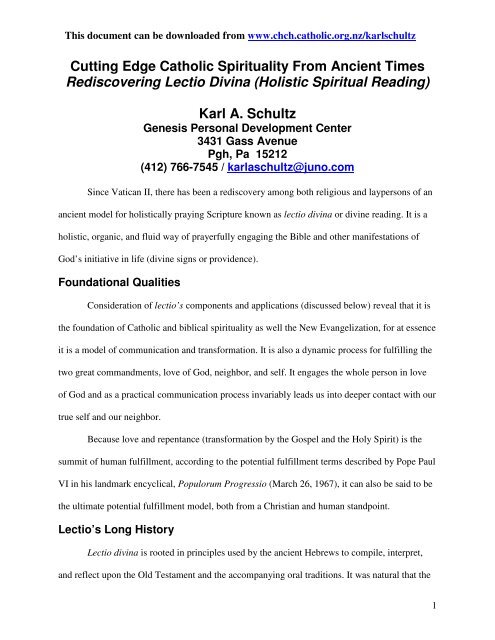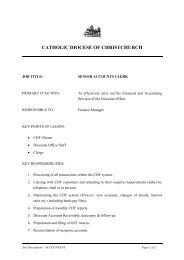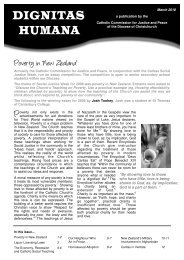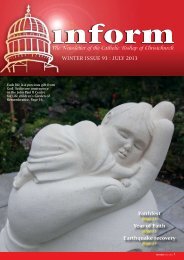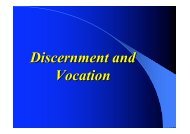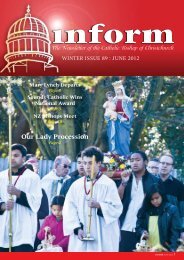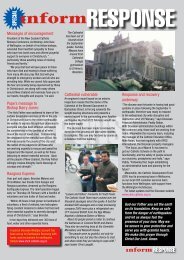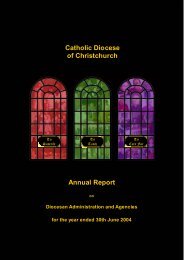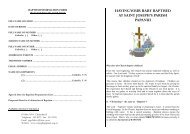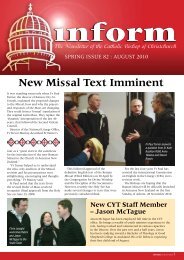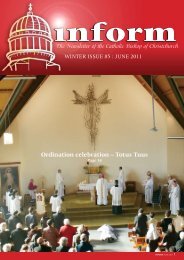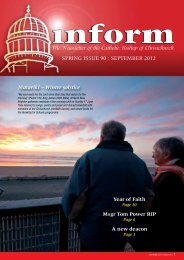Rediscovering Lectio Divina - Full Length.pdf
Rediscovering Lectio Divina - Full Length.pdf
Rediscovering Lectio Divina - Full Length.pdf
- No tags were found...
Create successful ePaper yourself
Turn your PDF publications into a flip-book with our unique Google optimized e-Paper software.
This document can be downloaded from www.chch.catholic.org.nz/karlschultzCutting Edge Catholic Spirituality From Ancient Times<strong>Rediscovering</strong> <strong>Lectio</strong> <strong>Divina</strong> (Holistic Spiritual Reading)Karl A. SchultzGenesis Personal Development Center3431 Gass AvenuePgh, Pa 15212(412) 766-7545 / karlaschultz@juno.comSince Vatican II, there has been a rediscovery among both religious and laypersons of anancient model for holistically praying Scripture known as lectio divina or divine reading. It is aholistic, organic, and fluid way of prayerfully engaging the Bible and other manifestations ofGod’s initiative in life (divine signs or providence).Foundational QualitiesConsideration of lectio’s components and applications (discussed below) reveal that it isthe foundation of Catholic and biblical spirituality as well the New Evangelization, for at essenceit is a model of communication and transformation. It is also a dynamic process for fulfilling thetwo great commandments, love of God, neighbor, and self. It engages the whole person in loveof God and as a practical communication process invariably leads us into deeper contact with ourtrue self and our neighbor.Because love and repentance (transformation by the Gospel and the Holy Spirit) is thesummit of human fulfillment, according to the potential fulfillment terms described by Pope PaulVI in his landmark encyclical, Populorum Progressio (March 26, 1967), it can also be said to bethe ultimate potential fulfillment model, both from a Christian and human standpoint.<strong>Lectio</strong>’s Long History<strong>Lectio</strong> divina is rooted in principles used by the ancient Hebrews to compile, interpret,and reflect upon the Old Testament and the accompanying oral traditions. It was natural that the1
This document can be downloaded from www.chch.catholic.org.nz/karlschultzearly church would use inherited methods since the church grew out of Judaism, continued tointeract with the rabbis, and identified with their Hebrew ancestors (cf. Heb 11). The Hebrews,of course, borrowed much from the cultures they interacted with, and in a very real sense we cantrace lectio divina’s lineage back to the first civilization, Sumer (modern day southern Iraq),where principles of reading, writing, and interpersonal communications were first refined. Thuswe are dealing with a model that is not only spiritual and transcendent but foundational anduniversal.We can also identify similar practices used by Muslims in reading the Koran, particularlyin a group --- which they refer to as circle study, for all the participants face each other out ofmutual respect and recognition of equality. While observing this practice my inadvertent turningmy back on the group momentarily was immediately perceived and I was gently informed of thegroup’s protocol.<strong>Lectio</strong> divina has been recommended enthusiastically by Popes John Paul II, BenedictXVI, the Pontifical Biblical Commission, the Catholic Catechism (nos. 1177, 2708), the CatholicBiblical Federation, and Cardinal Carlo Martini, S.J., archbishop emeritus of Milan and arenowned biblical scholar. Cardinal Martini has published over forty books on the subject andfostered awareness and practice throughout the world. He gave an outstanding presentation onlectio divina to the U.S. bishops at a conference in Collegeville, Minnesota in 1986. The text ofhis talk is included in the appendix to my book, Where is God When You Need Him?Components of <strong>Lectio</strong> <strong>Divina</strong><strong>Lectio</strong> divina is commonly described as being composed of five stages: reading/listening,meditation, prayer, contemplation, and action. Cardinal Martini incorporated three values centralto Jesuit spirituality: discernment, decision, and consolation. <strong>Lectio</strong> divina’s dynamic activitiesand holistic nature are such that it fosters personal growth and healing while deepening our2
This document can be downloaded from www.chch.catholic.org.nz/karlschultzspirituality and sense of community --- the latter is discussed in a book on lectio divina andinterpersonal relationships (Becoming Community, Biblical Meditations and ModernApplications, New City Press).To be authentic and efficacious, lectio must be bear fruit in fraternal charity: “ If any onesays, “I love God,” and hates his brother, he is a liar; for he who does not love his brother whomhe has seen, cannot love God whom he has not seen” (1 Jn 4:18).The Practice of <strong>Lectio</strong> <strong>Divina</strong>The following is a general description of the process and flow of lectio divina:I take a short passage of Scripture, perhaps from the lectionary (probably the best choice,particularly for beginners), the Liturgy of the Hours, a psalm, or a biblical book I am workingthrough, and read it slowly, whispering what I am reading aloud if not disturbing to others andunlikely to have me identified as intoxicated (as Hannah was accused during her prayer session;see 1 Sam 1:12-18) or disturbed (talking to myself). I look for a word, phrase, image, orexperience that speaks to me, and internalize it through repetition. I consider how this messageapplies to my life and the changes it calls forth in my attitudes and actions.After I encounter God’s word, it is natural that I interact directly with Him. I tell Himhow I feel both about this word and my life in general. I oscillate between these activecommunications and a receptive or listening mode, where I am simply present to God. I ask theHoly Spirit to open my heart and mind to His presence and activity in my life. To dispose myselfto a greater internalization of God’s gifts, I linger with Him as I would an intimate friend. Tosoothe my irritations and anxieties, I dispose myself to God's consolation, the peace beyondunderstanding mentioned by Paul (cf. Phil 4:7).3
This document can be downloaded from www.chch.catholic.org.nz/karlschultzTo make a transition from prayer to action, I make a gentle resolution to apply what Ireceived in lectio divina into practice. I then close with a prayer, whether in my own words orfrom Scripture (e.g., a Hail Mary or Lord’s Prayer, or part or all of a psalm).For Catholics, God's word is not exclusive to the Bible. It is present pre-eminently inJesus (cf. Jn 1:1-18), and is also found in church teaching, tradition, the sacraments, nature, andhuman beings, particularly those who are suffering and in need (cf. Mt 25:31-46). The entireGospel of John is dedicated to narrating how Jesus is the ultimate revelation of the Father andgiver of the Spirit.The Dynamism of <strong>Lectio</strong> <strong>Divina</strong><strong>Lectio</strong> divina is a dynamic, ongoing practice. I don't need to wait until my prayer time toengage in the activities of lectio divina. God is always taking the initiative with us, if only we areopen and responsive. The following are a sample of daily opportunities for holisticallyexperiencing God's word: relating openly with another person, experiencing some aspect ofnature, and reflecting or journaling on God's involvement in my day.The fundamental attribute of lectio divina is its Spirit-driven nature. There are no rigidrules or compulsive techniques. Just as human intimacy must be natural and dialogical, sointimacy with God must flow freely and peacefully. We begin by acknowledging that we do notknow how to pray, and thereby invite the Spirit to intercede for us (cf. Rom 8:26-27). Wedevelop the habit of trusting God at the controls without abandoning our responsibilities.People who pray are already practicing some form of lectio divina. Knowledge of itsobjectives / effects, components, and flow enables us to avoid sloppiness, refine our efforts, andoffer ourselves to God and each other more completely.4
This document can be downloaded from www.chch.catholic.org.nz/karlschultzApplications of <strong>Lectio</strong> <strong>Divina</strong>As a model of communications and potential fulfillment, lectio divina has applications tosuffering, care-giving, time and stress management, journaling, and gender vocations andrelationships. Although I have published books on each of these subjects, I frequently remindreaders and workshop participants that the activities of lectio divina are so natural, intuitive,reflexive, and ingrained that each of us have already practiced it in some form, and thus formaleducation and formation on it must always be considered secondary and supplementary ratherthan primary. That is, while it’s helpful to learn and dialogue about lectio, there is no substitutefor practicing it yourself, and learning through experience and direct encounter with our primaryinstructor, the Holy Spirit.So, what is stopping us? Let us open up our Bible, eyes, and heart, and let God’s wordtake root in us and bear fruit in our disposition, actions, and relationships.Practical Postscript: Responding to Dryness and DiscouragementWhich reminds me, if we are seeking an inspiration, word, or text for lectio divina, andnothing comes to us at the moment, we can always take refuge in the Lord’s words and exampleand pray the Our Father. This is particularly true when we are stressed or suffering and find ithard to focus on a biblical text or find the words and energy for prayer. Jesus lived and prayedthe Lord’s Prayer during his agonizing moments in the garden of Gethsemane.In living this prayer through the lectio cycle we become an example to both believers andnon-believers, witnessing that it is not the multiplication of words (cf. Mt 6:7) or the externalimage or gestures (cf. Mt 6:5) that makes our prayer efficacious, but the encounter with God weexperience in our inner room (cf. Mt 6:6) and the transformed life and relationships that ensue(cf. Mt 7:21-27).5
This document can be downloaded from www.chch.catholic.org.nz/karlschultzThe Ultimate Context of <strong>Lectio</strong> <strong>Divina</strong>We must always remember that the primary place we practice lectio divina is not inprivate, family, or group prayer, or in some inspiring natural setting, however essential they are.The context of lectio divina par excellence is the Eucharist, where we hear the word proclaimedin the assembly and receive the Word in the most personal way, through the gift of His body andblood. This memorial of Jesus’ passing over from dryness, discouragement, devastation, anddeath into total giving of himself to the Father and us gives us the grace to do the same and letthe Word dwell in and shine through us. In a frequently referenced passage (21), the Vatican IIDogmatic Constitution on Divine Revelation, Dei Verbum, comments:“The Church has always venerated the divine Scriptures just as she venerates the body ofthe Lord, since, especially in the sacred liturgy, she unceasingly receives and offers to thefaithful the bread of life from the table both of God's word and of Christ's body.” “Lord, give usthis bread always” (Jn 6:34).Karl A. Schultz is the director of Genesis Personal Development Center in Pittsburgh,Pennsylvania. He is one of the world’s most prolific speakers and writers on lectio divina. Hehas written twelve books on lectio divina and its various applications. His website iskarlaschultz.com, and he can be contacted at karlaschultz@juno.com.6


